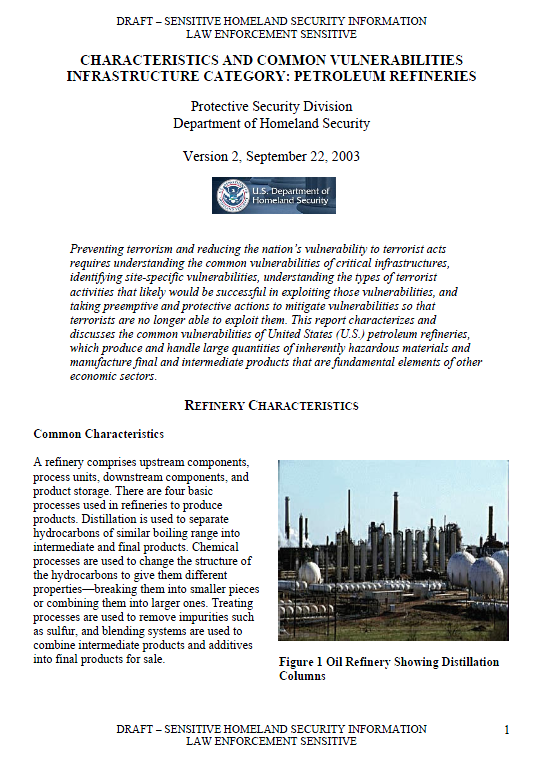CHARACTERISTICS AND COMMON VULNERABILITIES INFRASTRUCTURE CATEGORY: PETROLEUM REFINERIES
- 14 pages
- Law Enforcement Sensitive
- Sensitive Homeland Security Information
- September 22, 2003
A refinery comprises upstream components, process units, downstream components, and product storage. There are four basic processes used in refineries to produce products. Distillation is used to separate hydrocarbons of similar boiling range into intermediate and final products. Chemical processes are used to change the structure of the hydrocarbons to give them different properties—breaking them into smaller pieces or combining them into larger ones. Treating processes are used to remove impurities such as sulfur, and blending systems are used to combine intermediate products and additives into final products for sale.
…
Below is a list of components, equipment, and facilities typically found at refineries.
Upstream Components
• Crude oil pipelines entering the site, often aboveground within the refinery fence line
(may come from off site or from port/pier/dock/wharf)
• Crude oil pumps
• Crude heater
• Raw material pipelines (e.g., hydrogen)
• Port/pier/dock/wharf facilitiesProcess Units
• Desalter
• Atmospheric distillation unit
• Vacuum distillation unit
• Hydrocracking unit
• Fluidized-bed catalytic cracking unit (FCCU)
• Coker
• Continuous catalytic reformer (Platformer)
• Hydrotreater
• Alkylation unit
• Ultraformer
• Hydrogen production plant
• Gas separation unitSupport Components
• Operations control centers, including supervisory control and data acquisition
(SCADA) systems and process monitoring equipment
• Sulfur recovery unit
• Cooling towers
• Mixing manifolds (i.e., a very large, complicated, and unique arrangement of pipes,
valves, and interconnections from all over the refinery)
• Pumps
• Fire station/emergency response vehicles
Interdependencies
• Water supply pipeline
• Water pumps (off- and on-site)
• Water treatment plant (clarification)
• Underground wells
• Wastewater treatment plant
• Heat and steam plants (e.g., boiler house)
• Natural gas pipeline into the site (i.e., fuel for heat plants or cogeneration plants)
• Gas plant (fuel gas)
• Electric substations
• Electric cogeneration plants
• Telecommunications (i.e., radio, telephone, fiber optics)Downstream Components
• Refined product pipelines leaving the site, often aboveground within the refinery
fence line
• Port/pier/dock/wharf facilities for receipt of crude oil or delivery of refined product
by marine transport (e.g., ship or barge)
• Rail off-loading facilities
• Truck off-loading facilities (rack) for hazardous materials and/or refined productStorage
• Crude storage tanks
• Refined product storage tanks
• Ammonia storage vessels
• Hydrogen storage vessels
• Hydrofluoric (HF) acid storage vessels
• Butadiene/butane/propane/liquefied
petroleum storage vessels (spheres)
• Chlorine tanks

